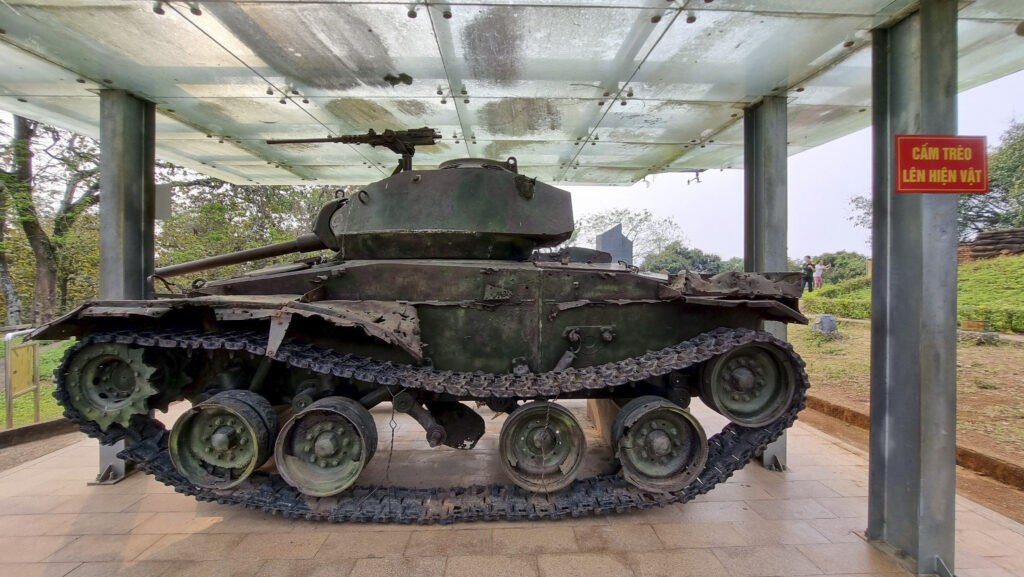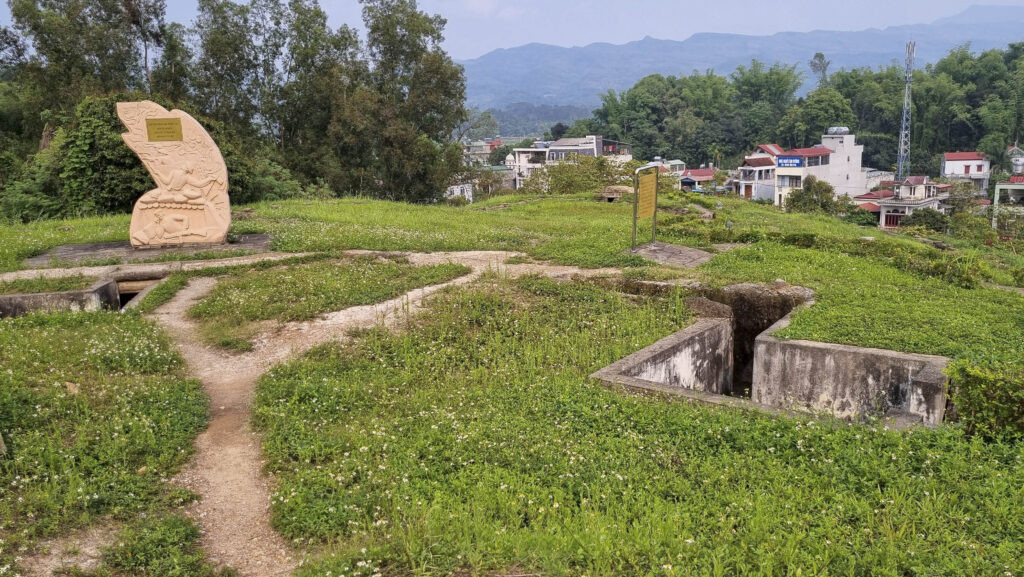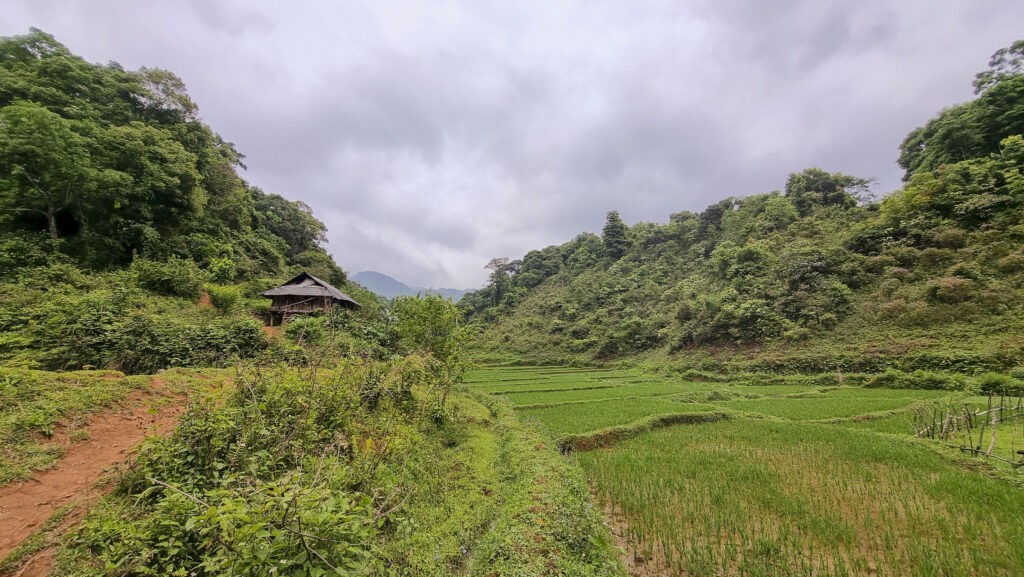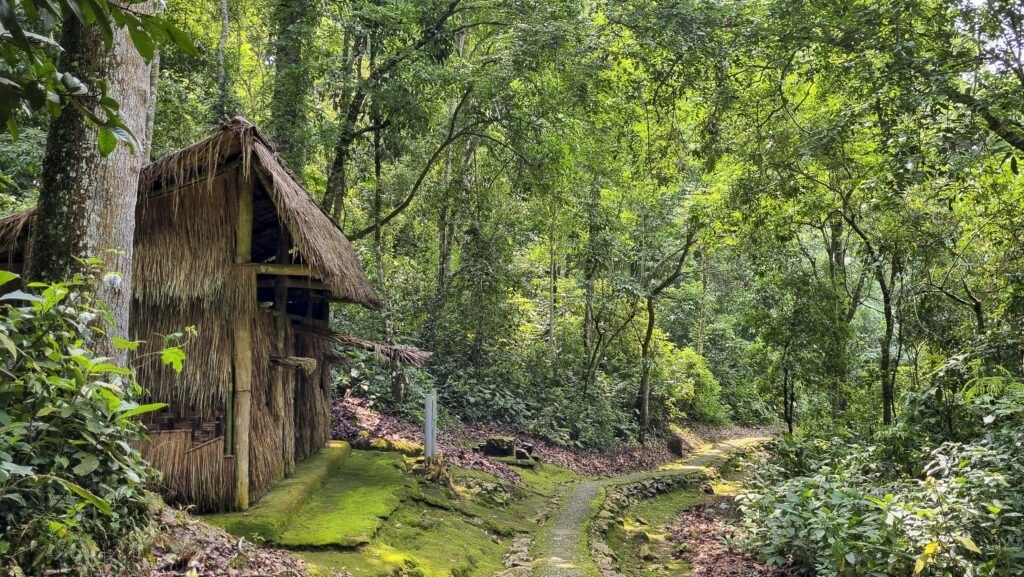Discover the historical treasures of Điện Biên Phủ, Vietnam, focusing on the iconic A1 Hill. SIXT.VN helps you explore the trenches, bunkers, crater, and monument, offering a convenient and insightful journey into Vietnam’s past. Let’s dive into the historical landscape, memorial sites, and battle remains of Điện Biên Phủ and how you can easily experience them with travel tips and logistical support.
1. What is the Historical Significance of A1 Hill in Điện Biên Phủ?
A1 Hill, also known as Eliane 2, is a pivotal site in the Điện Biên Phủ battlefield, symbolizing the fierce battle between the French and Viet Minh forces. This location was strategically vital, with intense fighting that significantly influenced the outcome of the war. According to historical accounts, the battle here involved relentless attacks and defenses, highlighting the strategic importance of this terrain. Exploring A1 Hill allows you to understand a crucial moment in Vietnamese history and appreciate the resilience of the Viet Minh forces. As you walk through the historical site, contemplate the events that transpired and the impact of this conflict on Vietnam’s independence.
2. What Trench Systems Can You Explore at A1 Hill?
At A1 Hill, you can explore an intricate network of trenches that bear witness to the intense combat that occurred here. These trenches, averaging about 1.7 meters in depth, served as crucial cover for soldiers during the prolonged siege. According to firsthand accounts, the trenches zigzag across the landscape, connecting machine gun nests and lookout points. Walking through these preserved trenches, you can gain a visceral sense of the conditions faced by soldiers on both sides. Be mindful of the terrain, as there may be hidden holes and wildlife, adding to the authentic experience.
 Trenches zigzagging through A1 Hill
Trenches zigzagging through A1 Hill
3. What Types of Bunkers Can You Find at A1 Hill?
A1 Hill features well-preserved bunkers that were critical for the French forces in defending their position. These bunkers, reinforced with PSP (pierced steel planking), offered protection against artillery fire and infantry assaults. The underground tunnels connecting the bunkers allowed for troop movement and supply lines, essential for sustaining the defense. Inside these bunkers, you can see the remnants of the living conditions and strategic layout that once housed French soldiers. Entering the muddy and dark tunnels offers a chilling glimpse into the claustrophobic reality of war.
4. What Caused the Large Crater at the Summit of A1 Hill?
The massive crater at the summit of A1 Hill is the result of a strategic Viet Minh operation involving a large underground mine detonated beneath a French bunker. This explosion was a turning point in the battle, destroying a key defensive position and demoralizing the French forces. According to historical records, the Viet Minh meticulously tunneled beneath the hill, placing a substantial amount of explosives to create this devastating impact. Standing at the edge of the crater, you can appreciate the ingenuity and determination of the Viet Minh forces in overcoming the French defenses.
5. What Memorials and Monuments Are Located at A1 Hill?
A1 Hill is home to several memorials and monuments that honor the soldiers who fought and died during the Battle of Điện Biên Phủ. These include the M24 Chaffee tank, which serves as a stark reminder of the armored warfare that took place, and various markers commemorating specific actions by Viet Minh soldiers. The Martyr Cemetery, located near A1 Hill, contains the graves of numerous unknown Viet Minh soldiers, providing a somber space for reflection. Visiting these memorials offers an opportunity to pay respects to the sacrifices made during the fight for Vietnamese independence.
 M24 Chaffee tank memorial at A1 Hill
M24 Chaffee tank memorial at A1 Hill
6. What Can You Learn at the Điện Biên Phủ Victory Museum?
Located across from A1 Hill, the Điện Biên Phủ Victory Museum offers an extensive collection of artifacts, photographs, and exhibits detailing the battle. The museum provides context and insights into the strategies, equipment, and personal stories of both sides involved in the conflict. According to museum records, exhibits include weaponry, uniforms, and detailed maps of the battlefield. Although the museum presents a narrative from the victor’s perspective, it provides valuable information about the historical significance of the battle. Exploring the Victory Museum enhances your understanding of the events that shaped Điện Biên Phủ and its lasting impact.
7. How Can SIXT.VN Enhance Your Trip to Điện Biên Phủ?
SIXT.VN offers comprehensive travel services to make your trip to Điện Biên Phủ seamless and enriching. From airport transfers and hotel bookings to guided tours, SIXT.VN ensures a convenient and comfortable experience. The challenges of planning a trip to a remote historical site can be daunting, but SIXT.VN provides reliable and efficient services tailored to your needs. Enjoy the peace of mind knowing that your travel arrangements are handled by experts, allowing you to focus on immersing yourself in the history and culture of Điện Biên Phủ.
8. What Other Historical Sites Should You Visit in Điện Biên Phủ?
Beyond A1 Hill, Điện Biên Phủ offers several other significant historical sites to explore. These include:
- Võ Nguyên Giáp’s Command Bunker: Located in the mountains, this complex served as the strategic headquarters for the Viet Minh forces.
- Strongpoint Beatrice: Explore the remnants of French defenses, including trenches and dugouts.
- Điện Biên Phủ Cemetery: A serene final resting place for thousands of soldiers who fought in the battle.
Visiting these sites provides a more complete understanding of the Điện Biên Phủ campaign and the diverse landscapes where the battles unfolded. Each site offers unique insights and perspectives on this pivotal moment in history.
9. What Are Some Travel Tips for Visiting A1 Hill?
To make the most of your visit to A1 Hill, consider these travel tips:
- Wear comfortable shoes: The terrain can be uneven and steep, requiring sturdy footwear.
- Bring water: Staying hydrated is essential, especially in the hot and humid climate.
- Hire a local guide: A knowledgeable guide can provide valuable insights and context.
- Be respectful: Remember that this is a memorial site, and treat it with the reverence it deserves.
By following these tips, you can ensure a safe, comfortable, and enriching experience at A1 Hill.
10. What Are the Best Times of Year to Visit Điện Biên Phủ?
The best times to visit Điện Biên Phủ are during the dry season, from October to April. During these months, the weather is more pleasant, with less rain and lower humidity. This makes it easier to explore the outdoor historical sites and enjoy the scenic landscapes. Avoid the rainy season, from May to September, as heavy rains can make travel more challenging and the terrain slippery. Planning your visit during the dry season will enhance your overall experience and allow you to fully appreciate the historical significance of Điện Biên Phủ.
11. How Can You Get to A1 Hill from Điện Biên Phủ Airport?
Getting to A1 Hill from Điện Biên Phủ Airport is relatively straightforward. You can take a taxi or motorbike taxi from the airport to the city center, where A1 Hill is located. The journey typically takes around 15-20 minutes by car. Alternatively, SIXT.VN offers convenient airport transfer services, ensuring a hassle-free journey to your hotel and other destinations in Điện Biên Phủ. Booking an airport transfer with SIXT.VN allows you to relax and start your historical exploration without any transportation worries.
12. What Type of Accommodation Options Are Available Near A1 Hill?
There are several accommodation options available near A1 Hill, ranging from budget-friendly guesthouses to more comfortable hotels. Many hotels are located in the city center, within walking distance or a short taxi ride from A1 Hill. SIXT.VN provides a variety of hotel booking options to suit your preferences and budget, ensuring a comfortable and convenient stay. Consider booking your accommodation in advance, especially during peak tourist season, to secure the best rates and availability.
13. What Cultural Insights Can You Gain from Visiting Điện Biên Phủ?
Visiting Điện Biên Phủ offers a unique opportunity to gain insights into Vietnamese culture, particularly its resilience and determination in the face of adversity. The historical sites and museums provide a deeper understanding of the country’s struggle for independence and the sacrifices made by its people. Additionally, interacting with locals and exploring the surrounding ethnic Thai villages allows you to appreciate the rich cultural diversity of the region. Immerse yourself in the local culture by trying traditional cuisine, attending cultural performances, and engaging in respectful interactions with the community.
 Ethnic Thai women in Điện Biên Phủ
Ethnic Thai women in Điện Biên Phủ
14. What Safety Precautions Should You Take When Exploring A1 Hill?
When exploring A1 Hill, it’s important to take certain safety precautions to ensure a safe and enjoyable experience. The terrain can be uneven, with hidden holes and trenches, so watch your step and wear sturdy footwear. It’s also advisable to stay on marked paths and avoid venturing into overgrown areas where you may encounter wildlife or unstable ground. Additionally, be mindful of the weather conditions and stay hydrated, especially during hot and humid days. By following these precautions, you can minimize risks and fully appreciate the historical significance of A1 Hill.
15. How Did Trench Warfare Play a Role in the Battle of Điện Biên Phủ?
Trench warfare was a defining characteristic of the Battle of Điện Biên Phủ, with both sides relying heavily on intricate systems of trenches and fortifications. The Viet Minh forces used trenches to encircle and isolate French strongholds, gradually tightening their grip on the battlefield. The French, in turn, constructed their own trenches and bunkers to defend against the Viet Minh assaults. The close-quarters combat within the trenches was brutal and relentless, resulting in heavy casualties on both sides. The trench systems at A1 Hill and other sites in Điện Biên Phủ bear testament to the intensity of this form of warfare and its impact on the outcome of the battle.
16. What Specific Military Equipment Can You See at A1 Hill?
At A1 Hill, you can observe various pieces of military equipment that played significant roles in the Battle of Điện Biên Phủ. One of the most prominent exhibits is the M24 Chaffee tank, which was used by the French forces. Additionally, you can see remnants of artillery pieces, barbed wire, and other fortifications that were part of the defensive and offensive strategies employed during the battle. These artifacts provide tangible connections to the military history of the site and offer insights into the technology and tactics used by both sides.
 Military equipment remnants at A1 Hill
Military equipment remnants at A1 Hill
17. What Can You Learn About French Colonial History in Điện Biên Phủ?
Điện Biên Phủ offers a profound lens through which to examine French colonial history in Vietnam. The battle marked a turning point in the First Indochina War, leading to the end of French rule in the region. Visiting Điện Biên Phủ allows you to reflect on the complexities of colonialism, the struggles for independence, and the lasting impact of French influence on Vietnamese society. The historical sites, museums, and local perspectives provide a multifaceted understanding of this critical period in history.
18. How Did Vo Nguyen Giap’s Leadership Impact the Battle of Điện Biên Phủ?
Vo Nguyen Giap’s leadership was instrumental in the Viet Minh victory at Điện Biên Phủ. As the commander of the Viet Minh forces, Giap orchestrated a strategic campaign that effectively encircled and defeated the French. His leadership was characterized by meticulous planning, adaptability, and a deep understanding of the terrain and the enemy. Visiting his command bunker in the mountains near Điện Biên Phủ provides insights into the conditions under which he planned and executed the battle. Giap’s leadership at Điện Biên Phủ solidified his reputation as one of the most brilliant military strategists of the 20th century.
 Vo Nguyen Giap's command bunker
Vo Nguyen Giap's command bunker
19. What Is the Significance of Strongpoint Beatrice in the Battle of Điện Biên Phủ?
Strongpoint Beatrice, also known as Him Lam, was one of the first French strongholds to fall during the Battle of Điện Biên Phủ. Its capture by the Viet Minh marked a crucial early victory that boosted their morale and disrupted French defensive plans. Exploring Strongpoint Beatrice today allows you to appreciate the strategic importance of this location and the challenges faced by both sides in the battle. The site’s unrestored trenches and dugouts provide a raw and authentic glimpse into the intensity of the fighting that took place here.
20. How Can You Respectfully Engage with Local Communities in Điện Biên Phủ?
Engaging respectfully with local communities in Điện Biên Phủ is essential for a meaningful and enriching travel experience. Show respect for local customs and traditions by dressing modestly, asking permission before taking photos, and being mindful of your behavior in sacred sites. Support local businesses by purchasing handicrafts, eating at local restaurants, and using local transportation services. Learn a few basic phrases in Vietnamese to facilitate communication and show your appreciation for the local culture. By engaging respectfully with the community, you can foster positive relationships and contribute to sustainable tourism in the region.
21. What Role Did Logistics Play in the Battle of Điện Biên Phủ?
Logistics played a pivotal role in the Battle of Điện Biên Phủ, particularly for the Viet Minh forces. The Viet Minh faced immense challenges in supplying their troops with food, ammunition, and medical supplies across difficult terrain. They relied on a network of porters, bicycles, and rudimentary roads to transport supplies from distant locations. The ability of the Viet Minh to sustain their logistical operations despite these challenges was a key factor in their victory. Understanding the logistical aspects of the battle provides a deeper appreciation for the resourcefulness and determination of the Viet Minh forces.
22. How Did the Battle of Điện Biên Phủ Impact Global Politics?
The Battle of Điện Biên Phủ had far-reaching consequences for global politics, signaling the end of French colonialism in Indochina and influencing the course of the Vietnam War. The Viet Minh victory demonstrated that a determined nationalist movement could defeat a major world power, inspiring other anti-colonial movements around the world. The Geneva Accords of 1954, which followed the battle, divided Vietnam into North and South, setting the stage for further conflict. The Battle of Điện Biên Phủ remains a significant event in the history of decolonization and the Cold War.
23. What Unique Photo Opportunities Are Available at A1 Hill?
A1 Hill offers numerous unique photo opportunities for capturing the historical significance and scenic beauty of the site. Some of the best photo spots include:
- The M24 Chaffee tank against the backdrop of the hills.
- The massive crater at the summit of A1 Hill.
- The intricate trench systems zigzagging across the landscape.
- Panoramic views of Điện Biên Phủ from the top of A1 Hill.
By taking advantage of these photo opportunities, you can create lasting memories of your visit to A1 Hill.
24. What Are Some Common Misconceptions About the Battle of Điện Biên Phủ?
There are several common misconceptions about the Battle of Điện Biên Phủ that should be clarified. One misconception is that the French were caught completely by surprise by the Viet Minh attack. In reality, the French were aware of the Viet Minh presence in the area but underestimated their capabilities and logistical capacity. Another misconception is that the Viet Minh victory was solely due to their superior numbers. While the Viet Minh did have a numerical advantage, their victory was also the result of strategic planning, effective leadership, and the determination of their soldiers.
25. How Can SIXT.VN Help You Book a Guided Tour of A1 Hill?
SIXT.VN offers a convenient and reliable way to book a guided tour of A1 Hill, ensuring a more informative and enriching experience. Our tour packages include knowledgeable local guides who can provide valuable insights into the history, significance, and cultural context of the site. With SIXT.VN, you can choose from a variety of tour options to suit your preferences and budget, whether you prefer a private tour or a group excursion. Booking a guided tour with SIXT.VN allows you to delve deeper into the history of A1 Hill and gain a more comprehensive understanding of the Battle of Điện Biên Phủ.
26. What Are the Key Differences Between A1 Hill and Other Historical Sites in Điện Biên Phủ?
While all historical sites in Điện Biên Phủ are significant, A1 Hill holds a unique place due to its central role in the battle and its well-preserved features. A1 Hill was one of the most heavily contested positions, and its capture by the Viet Minh was a turning point in the campaign. Unlike some other sites that have been more heavily restored or altered, A1 Hill retains much of its original character, with its intricate trench systems, bunkers, and the massive crater still visible. This authenticity makes A1 Hill a particularly compelling and evocative site to visit.
27. How Did the Local Population Support the Viet Minh During the Battle?
The local population played a crucial role in supporting the Viet Minh during the Battle of Điện Biên Phủ. They provided food, shelter, and logistical support to the Viet Minh soldiers, often at great personal risk. Local villagers helped transport supplies, construct roads, and gather intelligence, contributing significantly to the Viet Minh war effort. This support from the local population was a key factor in the Viet Minh victory and demonstrated the strong sense of national unity and determination to achieve independence.
28. What Can You Learn About Military Strategy from the Battle of Điện Biên Phủ?
The Battle of Điện Biên Phủ offers valuable lessons in military strategy, particularly in the context of asymmetric warfare. The Viet Minh forces, despite being outgunned and outequipped, were able to defeat the French through a combination of innovative tactics, effective leadership, and a deep understanding of the terrain. They used a strategy of encirclement and attrition, gradually weakening the French defenses and cutting off their supply lines. The Battle of Điện Biên Phủ is studied by military strategists around the world as an example of how a smaller, less well-equipped force can defeat a larger, more powerful adversary through strategic planning and tactical innovation.
29. How Can You Combine a Visit to A1 Hill with Other Attractions in Northwest Vietnam?
Combining a visit to A1 Hill with other attractions in Northwest Vietnam can create a diverse and enriching travel experience. You can explore the scenic landscapes of Sapa, visit the ethnic minority villages around Mai Châu, and discover the cultural heritage of Hòa Bình. SIXT.VN offers customized tour packages that combine historical exploration with cultural immersion and natural beauty. By combining a visit to A1 Hill with other attractions in Northwest Vietnam, you can gain a deeper appreciation for the region’s history, culture, and natural wonders.
30. What Resources Are Available for Further Research on the Battle of Điện Biên Phủ?
There are numerous resources available for those interested in conducting further research on the Battle of Điện Biên Phủ. These include:
- Books: Many scholarly and popular books have been written about the battle, offering detailed accounts and analyses.
- Documentaries: Several documentaries explore the battle from different perspectives, using archival footage and interviews.
- Museums: The Điện Biên Phủ Victory Museum and other museums in Vietnam offer exhibits and artifacts related to the battle.
- Academic Articles: Scholarly articles provide in-depth analyses of the battle’s military, political, and social aspects.
- Online Resources: Numerous websites and online archives offer primary source materials, photographs, and historical documents related to the battle.
By consulting these resources, you can deepen your understanding of the Battle of Điện Biên Phủ and its lasting impact.
FAQ: What Can Be Seen at the A1 Hill Site?
1. What exactly is A1 Hill?
A1 Hill, also known as Eliane 2, is a historically significant site in Điện Biên Phủ, Vietnam, where intense battles occurred during the First Indochina War.
2. Can I see original trenches at A1 Hill?
Yes, A1 Hill features a network of original trenches used during the battle, offering a glimpse into the conditions faced by soldiers.
3. Are there bunkers to explore at the site?
Yes, you can explore well-preserved bunkers that were critical for the French forces in defending their positions.
4. What caused the large crater at A1 Hill’s summit?
The crater resulted from a strategic Viet Minh operation, where a large underground mine was detonated beneath a French bunker.
5. Are there any memorials or monuments at A1 Hill?
Yes, the site includes the M24 Chaffee tank and the Martyr Cemetery, honoring soldiers who fought and died during the battle.
6. Is it safe to explore the trenches and bunkers?
While exploring, watch your step due to uneven terrain and potential hidden holes; staying on marked paths is recommended.
7. What can I learn at the Điện Biên Phủ Victory Museum nearby?
The museum features artifacts, photographs, and exhibits providing insights into the battle strategies and personal stories from both sides.
8. How can SIXT.VN help with my visit to A1 Hill?
SIXT.VN offers travel services, including airport transfers, hotel bookings, and guided tours for a convenient and comfortable experience. Address: 260 Cau Giay, Hanoi, Vietnam. Hotline/Whatsapp: +84 986 244 358. Website: SIXT.VN.
9. What other historical sites should I visit in Điện Biên Phủ?
Consider visiting Võ Nguyên Giáp’s Command Bunker, Strongpoint Beatrice, and the Điện Biên Phủ Cemetery for a comprehensive experience.
10. What is the best time to visit A1 Hill?
The dry season, from October to April, is ideal for visiting Điện Biên Phủ with pleasant weather for exploring historical sites.
Ready to explore the historic A1 Hill site in Điện Biên Phủ? Let SIXT.VN handle all your travel arrangements. From airport transfers to guided tours, we ensure a seamless and memorable experience. Contact us today and discover the rich history of Vietnam with ease. Visit SIXT.VN to learn more about our comprehensive travel packages.



